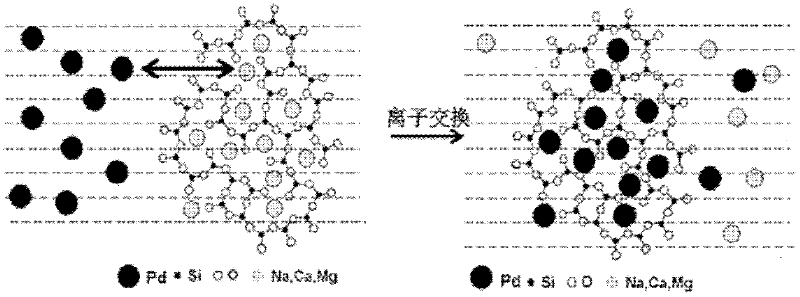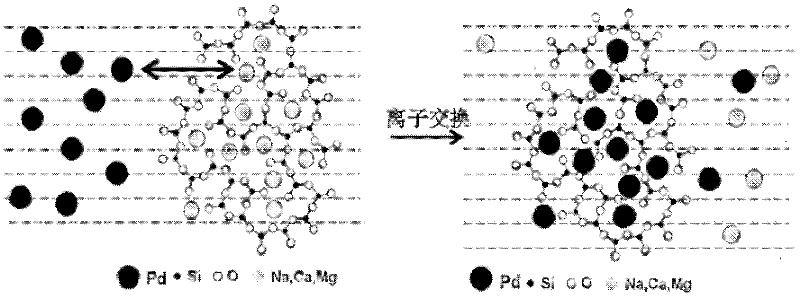Preparation method and application of nano monocrystal Pd core-shell catalyst
A nano-single crystal, core-shell technology, applied in catalyst activation/preparation, preparation of organic compounds, chemical instruments and methods, etc., can solve the problems of reducing catalytic activity, prone to agglomeration, etc. Pollution, good selectivity
- Summary
- Abstract
- Description
- Claims
- Application Information
AI Technical Summary
Problems solved by technology
Method used
Image
Examples
Embodiment 1
[0031] Take 1.5 g of porous glass microspheres etched by subcritical water and have a core-shell structure particle size of 95-105 μm and mix them with palladium chloride solution with an initial concentration of 100 ppm, and stir in a constant temperature water bath at 25°C for 24 hours. The color of the porous glass microspheres gradually changed from white to khaki. After the adsorption reached equilibrium, the porous glass microspheres loaded with palladium ions were taken out and washed 5 times with deionized water to remove the PdCl on the surface of the material. 2 . Then it was dried in an oven at 80°C. Place the dried porous glass microspheres in a hydrogen reduction furnace, heat them to 100°C in a hydrogen atmosphere to reduce the porous glass microspheres for 7 hours, and stop the flow of hydrogen after the samples are cooled to room temperature with the hydrogen reduction furnace, and then the nanometer cells can be obtained. Crystalline Pd core-shell catalysts....
Embodiment 2
[0033] Take 1.0 g of porous glass microspheres etched by subcritical water and have a core-shell structure particle size of 95-105 μm and mix them with palladium chloride solution with an initial concentration of 10 ppm, and stir in a constant temperature water bath at 35°C for 8 hours. The color of the porous glass microspheres gradually changed from white to khaki. After the adsorption reached equilibrium, the porous glass microspheres loaded with palladium ions were taken out and washed 6 times with deionized water to remove the PdCl on the surface of the material. 2 . Then it was dried in an oven at 60°C. Place the dry porous glass microspheres in a hydrogen reduction furnace, heat them to 200°C in a hydrogen atmosphere to reduce the porous glass microspheres for 5 hours, and stop the flow of hydrogen after the samples are cooled to room temperature with the hydrogen reduction furnace to obtain nanometer single particles. Crystalline Pd core-shell catalysts.
Embodiment 3
[0035] Take 3.0 g of porous glass microspheres etched by subcritical water and have a core-shell structure particle size of 95-105 μm and mix them with palladium chloride solution with an initial concentration of 60 ppm, and stir in a constant temperature water bath at 50° C. for 10 h. The color of the porous glass microspheres gradually changed from white to khaki. After the adsorption reached equilibrium, the porous glass microspheres loaded with palladium ions were taken out and washed 8 times with deionized water to remove the PdCl on the surface of the material. 2. Then it was dried in an oven at 90°C. Place the dry porous glass microspheres in a hydrogen reduction furnace, heat them to 300°C in a hydrogen atmosphere to reduce the porous glass microspheres for 4 hours, and stop the flow of hydrogen after the samples are cooled to room temperature with the hydrogen reduction furnace, and then the nanometer cells can be obtained. Crystalline Pd core-shell catalysts.
PUM
| Property | Measurement | Unit |
|---|---|---|
| particle diameter | aaaaa | aaaaa |
Abstract
Description
Claims
Application Information
 Login to View More
Login to View More - R&D
- Intellectual Property
- Life Sciences
- Materials
- Tech Scout
- Unparalleled Data Quality
- Higher Quality Content
- 60% Fewer Hallucinations
Browse by: Latest US Patents, China's latest patents, Technical Efficacy Thesaurus, Application Domain, Technology Topic, Popular Technical Reports.
© 2025 PatSnap. All rights reserved.Legal|Privacy policy|Modern Slavery Act Transparency Statement|Sitemap|About US| Contact US: help@patsnap.com



